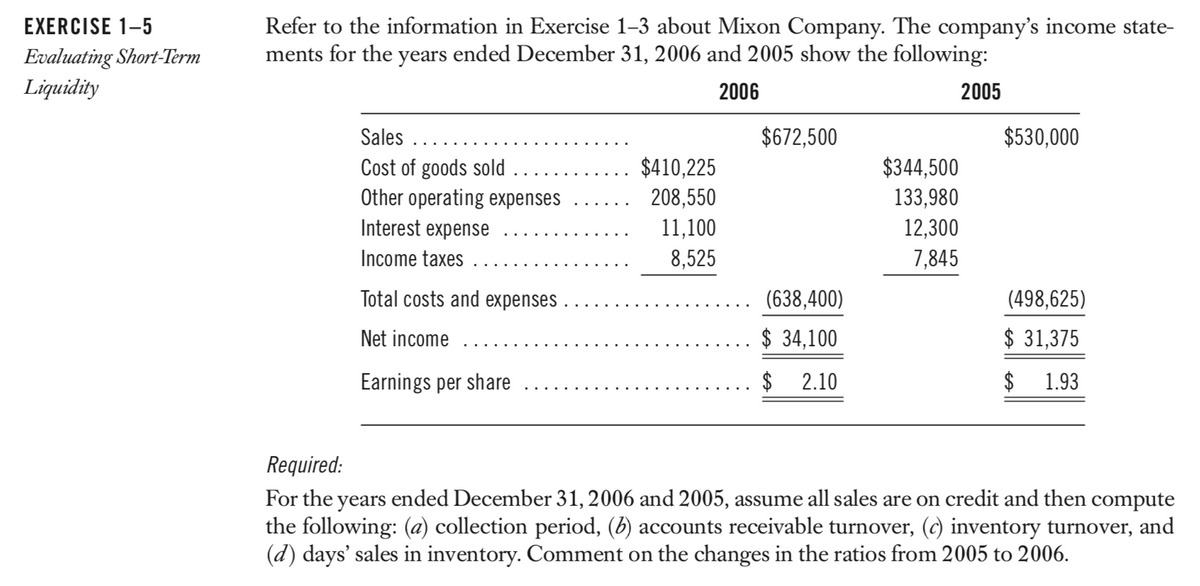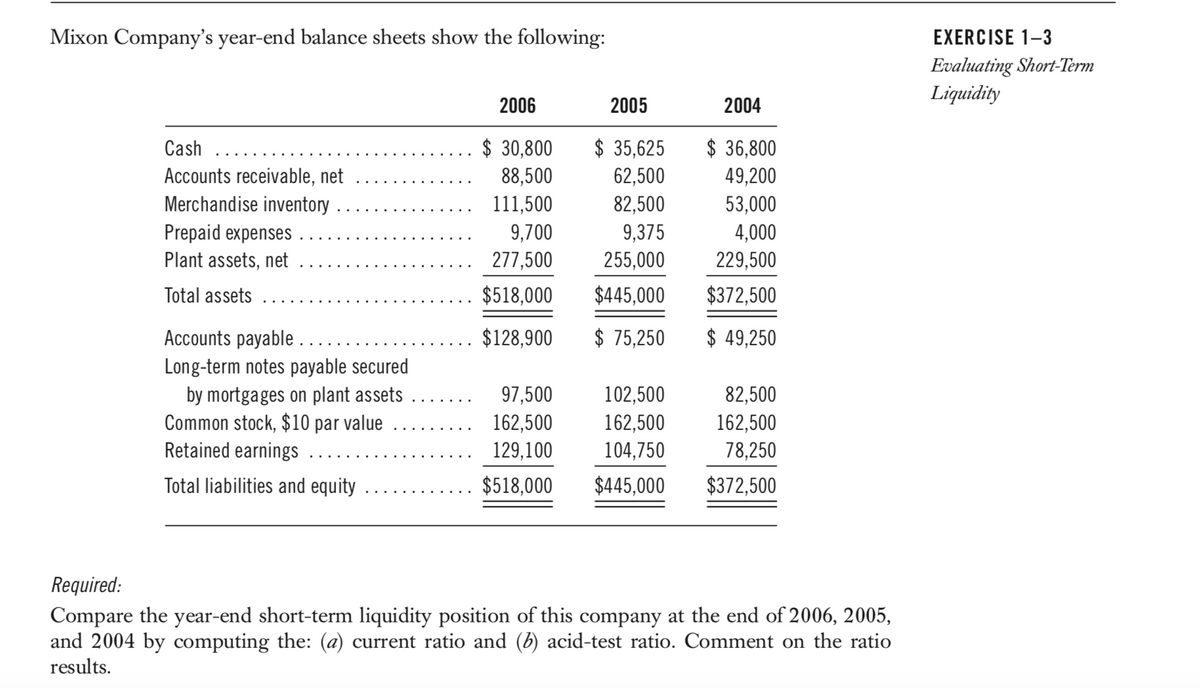see attached 1-3 and 1-5 to answer this Refer to the financial statements of Mixon Company in Exercises 1–3 and 1–5. Evaluate the effi- ciency and profitability of the company by computing the following: (a) net profit margin, (b) total asset turnover, and (c) return on total assets. Comment on these ratio results.
see attached 1-3 and 1-5 to answer this Refer to the financial statements of Mixon Company in Exercises 1–3 and 1–5. Evaluate the effi- ciency and profitability of the company by computing the following: (a) net profit margin, (b) total asset turnover, and (c) return on total assets. Comment on these ratio results.
Managerial Accounting: The Cornerstone of Business Decision-Making
7th Edition
ISBN:9781337115773
Author:Maryanne M. Mowen, Don R. Hansen, Dan L. Heitger
Publisher:Maryanne M. Mowen, Don R. Hansen, Dan L. Heitger
Chapter15: Financial Statement Analysis
Section: Chapter Questions
Problem 49E
Related questions
Question
see attached 1-3 and 1-5 to answer this
Refer to the financial statements of Mixon Company in Exercises 1–3 and 1–5. Evaluate the effi- ciency and profitability of the company by computing the following: (a) net profit margin, (b) total asset turnover, and (c) return on total assets. Comment on these ratio results.

Transcribed Image Text:EXERCISE 1-5
Evaluating Short-Term
Liquidity
Refer to the information in Exercise 1-3 about Mixon Company. The company's income state-
ments for the years ended December 31, 2006 and 2005 show the following:
2006
Sales
Cost of goods sold
Other operating expenses
Interest expense
Income taxes
Total costs and expenses
Net income
Earnings per share
$410,225
208,550
11,100
8,525
$672,500
(638,400)
$ 34,100
$ 2.10
$344,500
133,980
12,300
7,845
2005
$530,000
(498,625)
$ 31,375
$
1.93
Required:
For the years ended December 31, 2006 and 2005, assume all sales are on credit and then compute
the following: (a) collection period, (b) accounts receivable turnover, (c) inventory turnover, and
(d) days' sales in inventory. Comment on the changes in the ratios from 2005 to 2006.

Transcribed Image Text:Mixon Company's year-end balance sheets show the following:
Cash
Accounts receivable, net
Merchandise inventory
Prepaid expenses
Plant assets, net
Total assets
Accounts payable ..
Long-term notes payable secured
by mortgages on plant assets
Common stock, $10 par value
Retained earnings
Total liabilities and equity
2006
$ 30,800
88,500
111,500
9,700
277,500
$518,000
$128,900
97,500
162,500
129,100
$518,000
2005
2004
$ 35,625
$36,800
62,500
49,200
82,500
53,000
9,375
4,000
255,000
229,500
$445,000
$372,500
$ 75,250 $ 49,250
102,500
82,500
162,500
162,500
104,750
78,250
$445,000 $372,500
Required:
Compare the year-end short-term liquidity position of this company at the end of 2006, 2005,
and 2004 by computing the: (a) current ratio and (b) acid-test ratio. Comment on the ratio
results.
EXERCISE 1-3
Evaluating Short-Term
Liquidity
Expert Solution
This question has been solved!
Explore an expertly crafted, step-by-step solution for a thorough understanding of key concepts.
This is a popular solution!
Trending now
This is a popular solution!
Step by step
Solved in 4 steps

Knowledge Booster
Learn more about
Need a deep-dive on the concept behind this application? Look no further. Learn more about this topic, accounting and related others by exploring similar questions and additional content below.Recommended textbooks for you

Managerial Accounting: The Cornerstone of Busines…
Accounting
ISBN:
9781337115773
Author:
Maryanne M. Mowen, Don R. Hansen, Dan L. Heitger
Publisher:
Cengage Learning

EBK CONTEMPORARY FINANCIAL MANAGEMENT
Finance
ISBN:
9781337514835
Author:
MOYER
Publisher:
CENGAGE LEARNING - CONSIGNMENT

Cornerstones of Financial Accounting
Accounting
ISBN:
9781337690881
Author:
Jay Rich, Jeff Jones
Publisher:
Cengage Learning

Managerial Accounting: The Cornerstone of Busines…
Accounting
ISBN:
9781337115773
Author:
Maryanne M. Mowen, Don R. Hansen, Dan L. Heitger
Publisher:
Cengage Learning

EBK CONTEMPORARY FINANCIAL MANAGEMENT
Finance
ISBN:
9781337514835
Author:
MOYER
Publisher:
CENGAGE LEARNING - CONSIGNMENT

Cornerstones of Financial Accounting
Accounting
ISBN:
9781337690881
Author:
Jay Rich, Jeff Jones
Publisher:
Cengage Learning

Managerial Accounting
Accounting
ISBN:
9781337912020
Author:
Carl Warren, Ph.d. Cma William B. Tayler
Publisher:
South-Western College Pub

Intermediate Accounting: Reporting And Analysis
Accounting
ISBN:
9781337788281
Author:
James M. Wahlen, Jefferson P. Jones, Donald Pagach
Publisher:
Cengage Learning

Survey of Accounting (Accounting I)
Accounting
ISBN:
9781305961883
Author:
Carl Warren
Publisher:
Cengage Learning